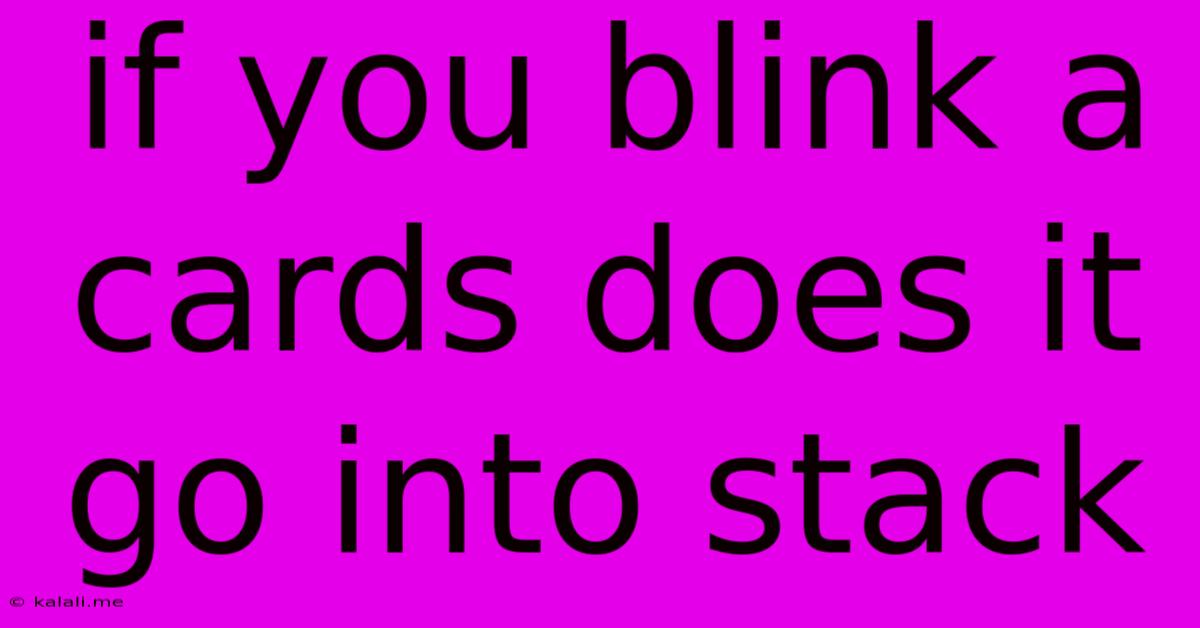If You Blink A Cards Does It Go Into Stack
Kalali
Jun 11, 2025 · 3 min read

Table of Contents
Does Blinking a Card in Magic: The Gathering Send It to the Stack? Understanding the Rules
Magic: The Gathering (MTG) is a game of intricate rules and strategic depth. One common question among players, especially newer ones, concerns the interaction between actions and the stack. This article clarifies whether blinking a creature (or any permanent) sends it to the stack. The short answer is no, but understanding why requires a deeper look at the game's mechanics.
What is the Stack?
The stack is a crucial part of MTG's gameplay. It's a temporary zone where spells and abilities are placed, resolving one at a time in a Last-In, First-Out (LIFO) order. This order allows players to respond to actions with their own spells or abilities, creating complex interactions and strategic choices. Think of it as a queue for actions waiting to be processed.
What is Blinking?
"Blinking" refers to temporarily removing a permanent (like a creature, enchantment, or artifact) from the battlefield and then returning it. This is usually achieved through effects that exile the permanent and then return it under the control of its owner. Examples include cards like [[Flickerwisp]], [[Ephemerate]], or abilities that create similar effects. The key is that the permanent leaves the battlefield and then comes back.
Why Blinking Doesn't Use the Stack (Most of the Time)
The crucial point is that the act of blinking itself doesn't go on the stack. The effect that causes the blinking—the spell or ability—does go on the stack. However, the removal and return of the permanent are usually handled as part of the resolution of that spell or ability, not as separate actions that would go on the stack.
This is because the blinking effect generally describes a single, continuous action that moves the permanent in and out of play, rather than distinct actions of removing and then returning. Think of it as a single, atomic operation. This is a common characteristic of many instant and sorcery spells, not just blinking. For example, when a creature is dealt lethal damage, it does not go to the stack, instead it immediately leaves the battlefield.
Exceptions to the Rule: Specific Card Interactions
While the typical blinking effect doesn't use the stack, there are rare exceptions. Some cards might have unusual wordings that create separate actions for the removal and return, thus placing those actions individually on the stack. Always carefully read the card text to see precisely what it does. Pay close attention to wording like "exile target permanent, then return it to the battlefield." In this case, each clause may represent a separate action affecting the stack.
Understanding the Difference is Key
The difference between the effect going on the stack and the result of that effect not going on the stack is essential for understanding MTG's rules. Many players misunderstand this point, but grasping it is crucial for mastering advanced gameplay and avoiding costly mistakes during a match.
In Summary:
While the spell or ability that causes the blink goes on the stack, the blinking action itself—the removal and return of the permanent—generally does not. This distinction is crucial for proper game play and understanding the intricacies of MTG's rules. Always refer to the specific card text for any ambiguities.
Latest Posts
Latest Posts
-
How Long Would It Take To Drive 2000 Miles
Jul 01, 2025
-
What Color Does Black And Blue Make
Jul 01, 2025
-
How To Pass Level 7 In Bloxorz
Jul 01, 2025
-
How Much Years Is 1 Billion Minutes
Jul 01, 2025
-
I Reject Your Reality And I Substitute My Own
Jul 01, 2025
Related Post
Thank you for visiting our website which covers about If You Blink A Cards Does It Go Into Stack . We hope the information provided has been useful to you. Feel free to contact us if you have any questions or need further assistance. See you next time and don't miss to bookmark.